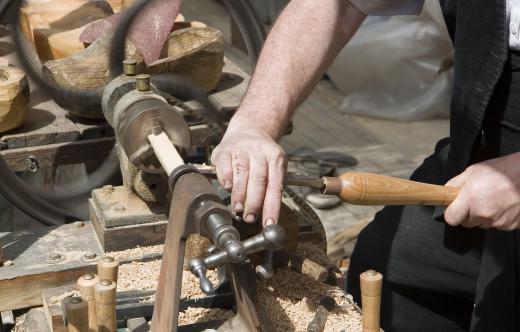Woodturning is one form of the art form known as woodworking. Essentially, woodturning involves using a lathe to create objects from some type of wood. As the lathe turns, the wood remains in the same position and slowly is shaped by the operation of the lathe. Using this basic process, it is possible to create many different objects from wood, including some designs that are intricate in detail.
The actual process of woodturning can be classified into two distinct methods. Spindle turning is a process that involves using wood where the grain runs in the same direction as the lathe bed. Items such as table legs, spindles for beds, and legs for chairs are examples of woodturning objects that are created using spindle turning.

A second approach to woodturning is known as faceplate turning. In this application, the wood grain runs vertical to the rotation of the lathe. Faceplate turning is the woodturning strategy of choice for such items as wooden platters, bowls, and charger plates.
Woodturning has a long history, reaching back to the 13th century BC. The Egyptians are credited with producing the first workable lathe that made woodturning possible. This model was structured to function with the aid of two people. One individual would man the cutting tool in order to shape the wood. The second individual supplied the power that caused the lather to turn, using a rope to keep up a consistent turning action.

Later, the Romans improved on the Egyptian design by adding a turning bow to the basic structure of the lathe. Woodturning continued to be a common skill after the fall of Rome and into the Middle Ages, with enhancements to the lathe design developed in Britain, France, and Germany. The major change to the lathe design was the addition of a pedal to maintain the turning action of the lathe. This left both hands free for the operator to manage the cutting tools and shape the design of the object. This design, usually referred to as a spring pole lathe, continues to be in common use today among artisans who prefer producing objects by hand rather than by mass production.

Mass production of various goods still often make use of the basic woodturning strategies employed by lathes. The difference is that today these mass produced goods are manufactured on machinery that holds the wood in place and uses computer technology to quickly shape the desired object. Where an artisan may spend hours or even days on a particular project, modern machinery can do the same job in minutes or even seconds.
Whether using simple lathes or modern machinery, woodturning still supplies many of the products people use regularly. Baseball bats are common examples of woodturning efforts, along with pool cues and pepper mills. Chess pieces are also created using woodturning methods, as well as elegantly carved wooden Lazy Susans and the individual bowls that are included in each level of the device. While mass produced items made with woodturning machinery are usually less expensive, many people still prefer objects created using more traditional woodturning methods.

